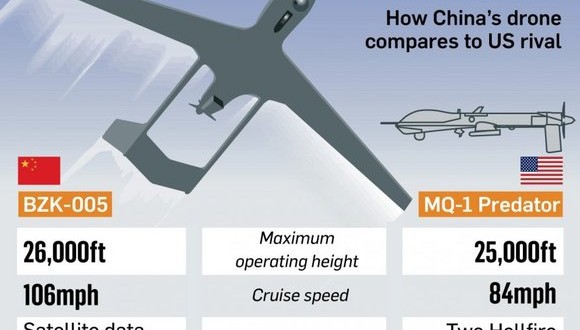
Harbin BZK-005 UAV
The BZK-005 high altitude, long range UAV is a reconnaissance aircraft designed by Beijing University of Aeronautics & Astronautics and Harbin Aircraft Industry (Group) Co., Ltd. It is used by the Chinese Navy.
At Zhuhai International Airshow 2006, video and models were demonstrated to the public regarding this UAV. BZK-005 has a few stealth features integrated into its design. It is believed that a satellite data link antenna is held in its large upper body dome. Under the body there are optic-electric sensor systems. It is expected that BZK-005 has cruising speed of around 170 km/h, service ceiling 8,000 m, max take off weight is around 1,200 kg, max payload over 150 kg.



Warplanes: China Unleashes UAVs Against Japan
November 4, 2013: On September 9th the Japanese Air Force sent interceptors aloft to check out an aircraft approaching Okinawa. It turned out to be a Chinese BZK-005 UAV. This is one of several UAVs built in China that are similar to the American Predator. The BZK-005 is a 1.2 ton UAV with a 150 kg (330 pound) payload, a cruising speed of 170 kilometers an hour, a satellite link, and an endurance of up to 20 hours. Since Okinawa is only 830 kilometers from the Chinese mainland, the BZK-005 could make it to the island, patrol for about 8 hours and return. While the BZK-005 turned back before it entered Japanese air space (anything over Okinawa or up to 22 kilometers from the coast) Japan warned China that if any of their UAVs violated Japanese air space they would be shot down. China responded that it would do the same.
China has more to fear from Japanese UAVs. That’s because Japan has access to more powerful sensors for its UAVs and is planning to buy American Global Hawk UAVs. At 13 tons the Global Hawk is the size of a commuter airliner (like the Embraer ERJ 145) but costs nearly twice as much. Global Hawk can be equipped with much more powerful, and expensive, sensors than other UAVs. The spy satellite quality sensors (especially AESA radar) are usually worth the expense because they enable the UAV, flying at about 20,000 meters, to get a sharp picture of all the territory it can see from that altitude. The BZK-005 can only reach 8,000 meters. A Japanese Global Hawk, flying at 20,000 meters just 24 kilometers from the Chinese coast, could get excellent images of land facilities hundreds of kilometers inland. This might tempt the Chinese to “accidentally” (by “miscalculating” how close it was to the Chinese coast) shoot down a Global Hawk. Both nations might do the same to the other side flying UAVs over disputed areas like the Senkaku Islands. There is much less hesitation about shooting down a UAV, since no one will get hurt.

Leave a Reply